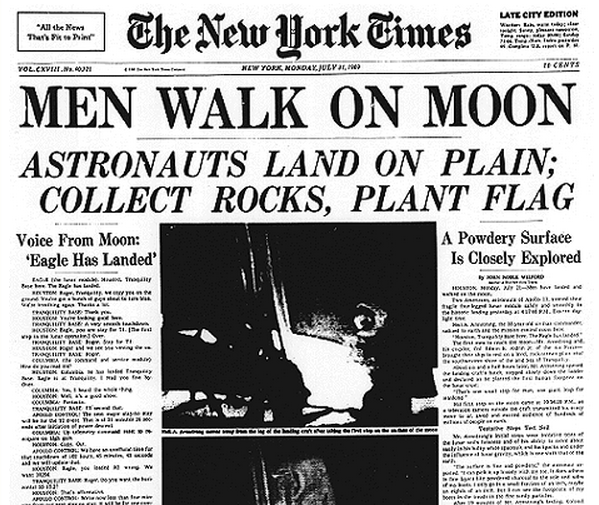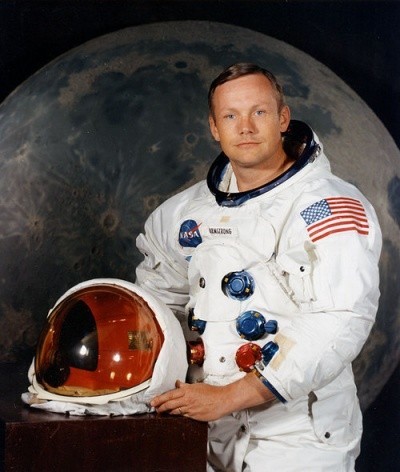 The New York Times: July 21, 1969
The New York Times: July 21, 1969Where were you?
We were near Jackson Hole, Wyoming, in a dust-brown Buick LeSabre with bench seats and camping gear stuffed in its huge trunk, pulled over in a wide spot at the side of a mountain road where we could get decent AM radio reception. That’s where we listened to Neil Armstrong and Buzz Aldrin land on the moon. I was eight.
Later that night we stayed in a motel — a major event in itself — so we could watch the first steps in glorious black-and-white on the motel TV.
Maybe you were at home. Maybe you were in a bar or watching on the big screen at Times Square. Maybe you were 20 years from being born, in which case your parents were undoubtedly watching. Everyone was watching.
And now Neil Armstrong — 39 years old when he set foot on the moon — has died at age 82.
 NASA photo
NASA photo
Neil Armstrong was exactly like a movie hero except for two things: no wisecracks and no rebel attitude. He was the ultimate competent man, starting with his 78 missions in the Korean War, through his days as a test pilot, then fixing the out-of-control spin in Gemini 8, then ejecting calmly at the absolute last second from a lunar trainer in 1968.
And then, oh, landing a primitive space ship on the moon. Neil Armstrong could handle it. He was The Man You Could Trust.
It’s hard to overdo the praise for Neil Armstrong, because his achievement was so outsized. He and Aldrin and Michael Collins and the slide-rule boys from NASA made it all seem calm and orderly. Even the incredibly dramatic landing, with Armstrong grabbing the controls to fly manually over moon boulders at the original landing site, finally touching down with a “hatful of fuel” left to burn — even that was done without shouting at the time, and without so much notice now. (Armstrong consistently played down the drama, naturally.)
Armstrong’s quietness in the years after his feat now seem amazing. No endorsements, no Wheaties box, no life-as-a-celebrity. He went back to Ohio, taught engineering not at Princeton or Yale but at the University of Cincinnati, did a little farming, and very rarely appeared in public.
Lots of people are talking about Neil Armstrong’s attitude now that he’s gone. Some say he was aloof, that he shunned fame, that he was a “bashful Galahad.” His first wife says it was hard on him: “Look what it’s done to him inside. He feels guilty that he got all the acclaim for an effort of tens of thousands of people… He took it too seriously to heart.”
Maybe. But I liked his style.
On Friday I had the good luck to tour the New York Times building in Manhattan, courtesy of David Corcoran, a family friend who edits the weekly Science Times section. It’s a groovy building for the electronic era, with big rooms full of cubicles and carpet and computer screens. We saw hardly any paper anywhere in the whole building, and surprisingly few mementos of the paper’s 161 years of reporting.
But along one wall of the science team’s room was a glass-fronted wooden box with a folded newspaper inside: the Monday, July 21, 1969 edition of the New York Times. MEN WALK ON MOON.
It was amazin’ at the side of a mountain road in Wyoming, and it’s still amazin’ today. What a man.
See our biography of Neil Armstrong »
